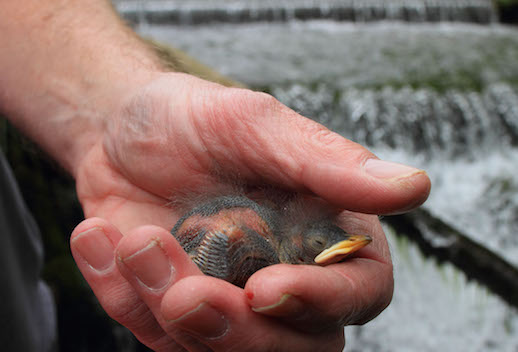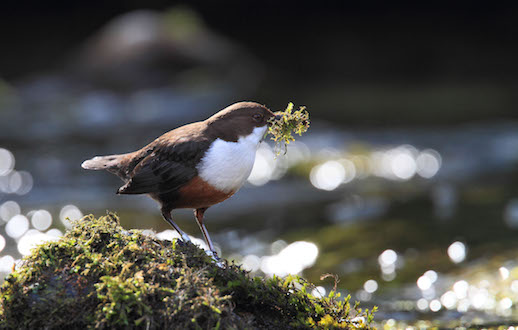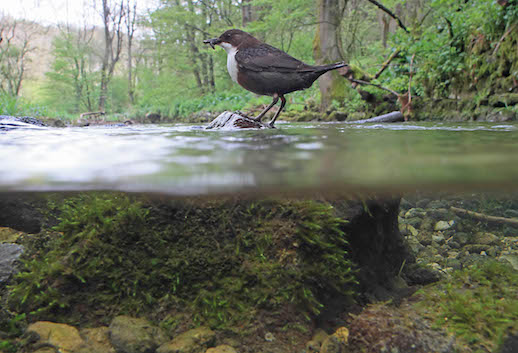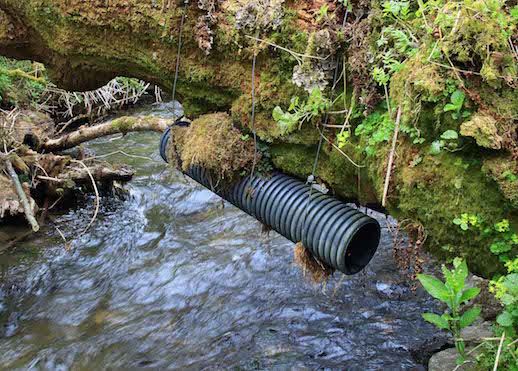A dip, a flirt of the tail, – he’s gone!
Brown as the stump he now sits on.
(Robin Dale)
Words and pictures: Mat Bingham
Dippers are about the size of a robin and are in fact related to them, their breast is chestnut brown and unlike robins, they have a white bib. Similar to other water birds such as grey wagtails and in particular kingfishers they bob up and down, as if they are getting down to the latest tune, but only they can hear it. This together with their manic, rapid, short flight following the course of a river is their jizz. They look to me like they don’t enjoy flying much, but they do like a good paddle underwater looking for something to eat.
Dippers hunt underwater, but unlike kingfishers, rather than diving headlong into the water like a torpedo from a helicopter on anti-submarine manoeuvres, they just walk right on in like a Victorian going for a bathe in the sea. Once underwater, they scurry about looking for tasty morsels, overturning rocks with their feet or beak, having a good root around. They can paddle underwater surprisingly well; in fact they really are rather good swimmers. They seem to be able to fight against their natural buoyancy and the current with quite some skill and enthusiasm. Generally they take small crustaceans and aquatic larvae such as caddis and damsel flies. They have been known to catch small fish such as bullheads, a testament to their skills below the water as they are not ambush predators.
They have a curious song and are particularly vocal in the spring when looking for a mate and protecting their territory. The tune they sing is a series of short bursts at a very high pitch, designed to be heard above the sound of rushing water. The song is very similar in pitch to that of the grey wagtail so this would suggest they both evolved this ability because of the environment they live in.
For nesting they like nothing better than a small crevice between rocks, often behind a waterfall. They seem happy to get a good dunking every time they arrive or depart the nest when feeding their young. In fact this probably helps keep them clean and free of parasites. I have seen dippers deliberately dive into the water mid-flight and can only conclude that they are having a quick wash whilst busying themselves about their day. They are equally at home using pieces of pipe for nesting sites and appear in some cases to prefer them to natural locations.
Females tend to do most of the work brooding and feeding their young. I spent much of the spring in 2013 watching a pair at the nest. The hen bird would let her other half bring her some breakfast, but once she had finished eating she appeared to tell him to clear off, chirping furiously at him, and not in a nice way! Often he would not be seen for the rest of the day. It didn’t take him long before he started entertaining another female upriver so dippers don’t seem particularly monogamous.
The hen bird generally lays in the region of four eggs in her mossy lined hollow. She normally spends two to three weeks on the nest incubating the eggs before the chicks hatch. The chicks are really quite well house trained; they keep their home clean by turning around in the nest and pointing their behind towards the entrance every time they need to poo. They eject a faecal sack, which normally falls into the river or stream below where it immediately breaks up and dissipates in a cloud of white. As well as keeping the nest clean and parasite free, they appear to do this so as not to attract the attention of unwelcome visitors.
 Dipper Chicks (I should say that when I took this photograph these chicks were being ringed by a BTO Bird Ringer)
Dipper Chicks (I should say that when I took this photograph these chicks were being ringed by a BTO Bird Ringer)
After about five weeks the chicks fledge and leave the nest. The adults, usually the female, feed the fledglings for a further week before they try and make it on their own in the big wide world. In good years a pair may have two broods. They seem pretty loyal to their preferred nest sites. I have watched a female use the same nest site for several years in a row. I know this was the same female as she used the same rock to launch herself up to the nest every time and on exiting the nest, would have a paddle in the same spot of the river. They do like routine!
Once the adult birds have finished breeding for the year, they almost vanish for a time as they moult, skulking about in the shadows.
They can be susceptible to disturbance, and bad weather can have a big impact on numbers. Where I have been watching them over the years, they seem to be holding their own in terms of numbers of adult birds. Water quality improvements resulting in more invertebrates that they rely on for food and better quality nesting sites may be giving the dipper a fighting chance. Long may the dipper and its silent disco continue to be seen on our rivers!
See more of Mat’s stunning wildlife photography on his website, Tales from the River


